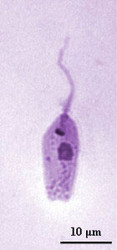Crithidia
Julius Lukes- Crithidia fasciculata
- Crithidia luciliae
Introduction
Within the last 100 years, the genera Leptomonas, Crithidia, Blastocrithidia, Wallaceina and Herpetomonas have been described based on the presence and/or combination of morphs in their life cycles. Some insect trypanosomatids contain a bacterial endosymbiont in their cytoplasm, which divides synchronously with the host cell (de Souza and Motta 1999). Aposymbiotic strains can be obtained by treatment of insect trypanosomatids with antibiotics. The presence of the endosymbiont is associated with morphological changes, such as a cryptic paraflagellar rod (Gadelha et al., 2005). However, recent careful investigations of numerous new species isolated from insects showed that the taxonomy based on morphology is invalid for several reasons:
- there is much higher variability in morphology of a given species than anticipated
- for a given species, different stages can be found in the host and in the culture
- molecular phylogeny showed that none of these genera represents a monophyletic assembly of species.
Therefore, sequence data derived from conserved genes such as GAPDH, SL RNA and 18S rRNA should be used as main criteria for improved systematics of the insect trypanosomatids (Yurchenko et al., 2006; 2008). Until this work has been done, it is not clear whether the species currently placed in the genus Crithidia form a monophyletic group.
References
De Souza W. and M.C.M. Motta. 1999. Endosymbiosis in protozoa of the Trypanosomatidae family. FEMS Microbiol. Lett. 173: 1-8.
Gadelha C., B. Wickstead, W. de Souza, K. Gull and N. Cunha-e-Silva. 2005. Cryptic paraflagellar rod in endosymbiont-containing kinetoplastid protozoa. Eukaryot. Cell 4: 516-525.
Yurchenko V., J. Lukeš, X. Xu and D.A. Maslov. 2006. An integrated morphological and molecular approach to a new species description in the Trypanosomatidae: the case of Leptomonas podlipaevi n.sp., a parasite of Boisea rubrolineata (Hemiptera: Rhopalidae). J. Euk. Microbiol. 53: 103-111.
Yurchenko V.A., J. Lukeš, M. Tesařová, M. Jirků and D.A. Maslov. 2008. Morphological discordance of the new trypanosomatid species phylogenetically associated with the genus Crithidia. Protist 159: 99-114.
Title Illustrations

| Scientific Name | Crithidia luciliae |
|---|---|
| Source | Crithidia luciliae |
| Source Collection | Micro*scope |
| Image Use |
 This media file is licensed under the Creative Commons Attribution-NonCommercial-ShareAlike License - Version 2.5. This media file is licensed under the Creative Commons Attribution-NonCommercial-ShareAlike License - Version 2.5.
|
| Copyright | © Guy Brugerolle |
About This Page
This page is being developed as part of the Tree of Life Web Project Protist Diversity Workshop, co-sponsored by the Canadian Institute for Advanced Research (CIFAR) program in Integrated Microbial Biodiversity and the Tula Foundation.

University of South Bohemia in Ceske Budejovice, Czech Republic
Correspondence regarding this page should be directed to Julius Lukes at
Page copyright © 2009
All Rights Reserved.
- First online 02 January 2009
- Content changed 02 January 2009
Citing this page:
Lukes, Julius. 2009. Crithidia . Version 02 January 2009 (under construction). http://tolweb.org/Crithidia/98017/2009.01.02 in The Tree of Life Web Project, http://tolweb.org/








 Go to quick links
Go to quick search
Go to navigation for this section of the ToL site
Go to detailed links for the ToL site
Go to quick links
Go to quick search
Go to navigation for this section of the ToL site
Go to detailed links for the ToL site